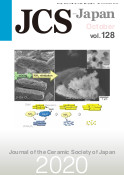128 巻, 10 号
(October)
選択された号の論文の28件中1~28を表示しています
- |<
- <
- 1
- >
- >|
-
2020 年 128 巻 10 号 p. H10-1
発行日: 2020/10/01
公開日: 2020/10/01
PDF形式でダウンロード (232K) -
2020 年 128 巻 10 号 p. C10-1-C10-5
発行日: 2020/10/01
公開日: 2020/10/01
PDF形式でダウンロード (1881K)
Feature: “Green processing and Green energy materials for sustainable society” on PACRIM 13: Preface
-
2020 年 128 巻 10 号 p. P10-1-P10-2
発行日: 2020/10/01
公開日: 2020/10/01
PDF形式でダウンロード (67K)
Feature: “Green processing and Green energy materials for sustainable society” on PACRIM 13: Full papers
-
2020 年 128 巻 10 号 p. 665-669
発行日: 2020/10/01
公開日: 2020/10/01
PDF形式でダウンロード (13906K) -
2020 年 128 巻 10 号 p. 670-676
発行日: 2020/10/01
公開日: 2020/10/01
PDF形式でダウンロード (2644K) -
2020 年 128 巻 10 号 p. 677-684
発行日: 2020/10/01
公開日: 2020/10/01
PDF形式でダウンロード (19474K) -
2020 年 128 巻 10 号 p. 685-692
発行日: 2020/10/01
公開日: 2020/10/01
PDF形式でダウンロード (4720K) -
2020 年 128 巻 10 号 p. 693-699
発行日: 2020/10/01
公開日: 2020/10/01
PDF形式でダウンロード (4074K) -
2020 年 128 巻 10 号 p. 700-705
発行日: 2020/10/01
公開日: 2020/10/01
PDF形式でダウンロード (1404K) -
2020 年 128 巻 10 号 p. 706-709
発行日: 2020/10/01
公開日: 2020/10/01
PDF形式でダウンロード (2627K)
Regular Issue: Special Articles: The 74th CerSJ Awards for Academic Achievements in Ceramic Science and Technology: Review
-
2020 年 128 巻 10 号 p. 710-717
発行日: 2020/10/01
公開日: 2020/10/01
PDF形式でダウンロード (2452K) -
2020 年 128 巻 10 号 p. 718-737
発行日: 2020/10/01
公開日: 2020/10/01
PDF形式でダウンロード (20614K) -
2020 年 128 巻 10 号 p. 738-746
発行日: 2020/10/01
公開日: 2020/10/01
PDF形式でダウンロード (17369K) -
2020 年 128 巻 10 号 p. 747-755
発行日: 2020/10/01
公開日: 2020/10/01
PDF形式でダウンロード (7245K)
Regular Issue: Full papers
-
2020 年 128 巻 10 号 p. 756-760
発行日: 2020/10/01
公開日: 2020/10/01
PDF形式でダウンロード (1282K) -
2020 年 128 巻 10 号 p. 761-765
発行日: 2020/10/01
公開日: 2020/10/01
PDF形式でダウンロード (2343K) -
2020 年 128 巻 10 号 p. 766-771
発行日: 2020/10/01
公開日: 2020/10/01
PDF形式でダウンロード (364K) -
2020 年 128 巻 10 号 p. 772-782
発行日: 2020/10/01
公開日: 2020/10/01
PDF形式でダウンロード (5075K) -
2020 年 128 巻 10 号 p. 783-789
発行日: 2020/10/01
公開日: 2020/10/01
PDF形式でダウンロード (20664K) -
2020 年 128 巻 10 号 p. 790-797
発行日: 2020/10/01
公開日: 2020/10/01
PDF形式でダウンロード (7655K) -
2020 年 128 巻 10 号 p. 798-804
発行日: 2020/10/01
公開日: 2020/10/01
PDF形式でダウンロード (1345K) -
2020 年 128 巻 10 号 p. 805-811
発行日: 2020/10/01
公開日: 2020/10/01
PDF形式でダウンロード (3448K) -
2020 年 128 巻 10 号 p. 812-820
発行日: 2020/10/01
公開日: 2020/10/01
PDF形式でダウンロード (3406K) -
2020 年 128 巻 10 号 p. 821-831
発行日: 2020/10/01
公開日: 2020/10/01
PDF形式でダウンロード (9472K) -
2020 年 128 巻 10 号 p. 832-838
発行日: 2020/10/01
公開日: 2020/10/01
PDF形式でダウンロード (1018K)
Regular Issue: Notes
-
2020 年 128 巻 10 号 p. 839-842
発行日: 2020/10/01
公開日: 2020/10/01
PDF形式でダウンロード (2754K) -
2020 年 128 巻 10 号 p. 843-846
発行日: 2020/10/01
公開日: 2020/10/01
PDF形式でダウンロード (586K)
Announcement
-
2020 年 128 巻 10 号 p. A10-1
発行日: 2020/10/01
公開日: 2020/10/01
PDF形式でダウンロード (73K)
- |<
- <
- 1
- >
- >|
